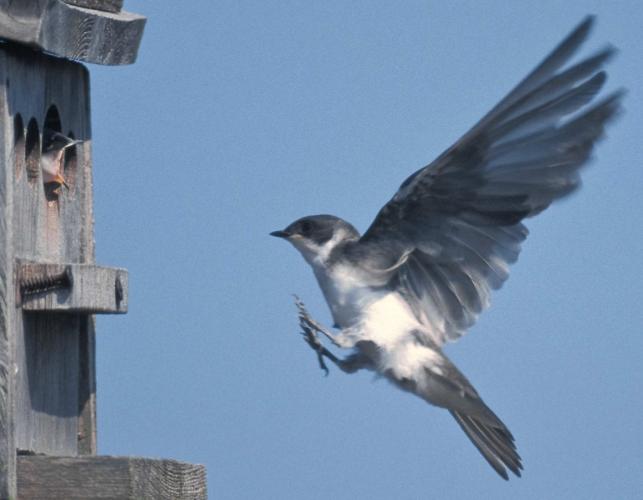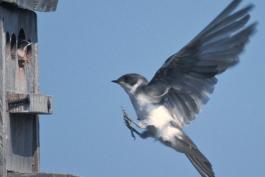
The upperparts of adult tree swallows appear dark but are glossy blue in the sunlight, appearing blue green in the fall. They have a difficult-to-see black forehead and eye line. The underparts are bright white, which helps distinguish tree swallows from rough-winged swallows. Young males resemble adult males, but young females are brownish above for several years. The song is variable, often three notes followed by a twittering or gurgling warble. The call is a chirpy one-or two-syllable chee-weet or chweet-twit-clweet, often described as a liquid sound.
Similar species: Six species of swallows nest in Missouri.
Length: 5¾ inches (tip of bill to tip of tail).
Statewide.
Habitat and Conservation
In Missouri, tree swallows are usually seen during migration near lakes and rivers. The ones that remain in our state during summer nest in tree cavities over water on lakes, reservoirs, ponds, and rivers.
See Life Cycle below for tips on viewing migrating swallows.
Food
Forages on the wing for flying insects. Tree swallows, like other swallows, are fast, nimble fliers and use their aerodynamic skills to hunt flying insects in the air. Focusing their foraging activities around wetlands, lakes, and other bodies of water, they typically eat flying insects associated with wet habitats: damselflies, dragonflies, mayflies, stoneflies, caddisflies, true flies, butterflies and moths, bees, wasps, beetles, true bugs, and other invertebrates such as spiders.
During cold snaps in late winter when insects are scarce, tree swallows commonly survive by eating berries (especially bayberries) and other small fruits and seeds.
Status
Common transient (migrant) statewide. As summer (breeding) resident, uncommon and local. Accidental winter visitor.
Life Cycle
In Missouri, migrating tree swallows begin arriving in very late February and March. Spring numbers peak the second half of April. Some remain present through the summer. In fall, migrating numbers peak in late September and early October. By about the middle of November, none remain in Missouri.
Missouri is in the more southerly portion of the tree swallow’s summer breeding range, which extends well north into Canada and Alaska. They are named tree swallows because they nest in tree cavities, such as old woodpecker nests. (Other swallows typically nest in earth embankments or build pot-shaped nests out of mud.) Tree swallows prefer nest trees that are located over water on lakes, reservoirs, ponds, and rivers. They will also nest in bird boxes, including those constructed for eastern bluebirds.
Females do most of the nest building, lining the cavity with grass and other soft plant material, animal fur, and a variety of other items, including the feathers of other types of birds. A clutch comprises 4–7 eggs, which are incubated for 11–20 days. After hatching, the young remain in the nest for a further 15–25 days.
A tree swallow can live for at least 12 years.
Like our other breeding resident swallows, tree swallows eat insects, so they begin to arrive with warmer weather in spring to seek out places to nest and raise their young. By midsummer, most of the swallows have raised one brood and are no longer attending a nest. In July and August, swallows begin to gather in ever-larger groups, sitting on power lines, on rooftops, or near wetlands. It is not uncommon to see a flock of 1,000 or more in midsummer, but you may discover in a visit to a wetland area in August that a 100,000 or more individuals of all six of our swallow species have joined into one large group. They are most likely to be seen in the late afternoon, about an hour before sunset, or early morning as they come to feed on insects near the water and roost on marsh vegetation. Migrants from farther north join with birds from Missouri to make a truly spectacular event.
Farther south along the migration pathway, in the southern United States and along the coasts of Central America, flocks of several million birds have been reported.
Human Connections
It’s fun to watch swallows as they fly around catching insects. Putting up a nest box before they arrive in spring (make sure to include an anti-predator guard) may attract tree swallows to your property. The design for tree swallow nest boxes is very similar to that of eastern bluebird boxes.
Since the mid-1960s, tree swallow populations have declined by nearly 50 percent in North America, and people have had a role in the shrinking numbers. Tree swallows need appropriate nesting sites: standing dead trees (snags) with woodpecker holes and other cavities. When people remove snags to clean up their property, they remove places for swallows to nest. Putting up appropriately designed nest boxes can help. Allowing snags to remain standing can also help.
Some other reasons for declining populations of tree swallows are related to humans, too. As insect eaters, tree swallows may be harmed by pesticides and other toxic chemicals, which can build up within their bodies.
Climate change, caused primarily by fossil-fuel exhaust emissions and deforestation, is also a threat. Projections show that, if humans don’t do anything to slow or halt greenhouse emissions, and there is a 3-degree increase in overall temperatures, there would be an eventual loss of more than 40 percent of the tree swallow’s summer breeding range. The lost territory would likely include most of the tree swallow’s current breeding territory in the lower 48 states, including Missouri. Increased hot temperatures, especially in spring, would endanger the lives of nestlings. A warmer climate would also lead to increased chances of wildfires. Climate change has also been linked to a change in tree swallows’ breeding patterns. As the temperatures in springtime have gradually risen in the past half-century, tree swallows have been nesting earlier.
Ecosystem Connections
Tree swallows play a role in checking the populations of the many flying insects they consume. When they eat berries and other fruit, they may serve to disperse the seeds to new places away from the parent plant.
Numerous predators hunt tree swallow young in the nest, including ratsnakes, raccoons, rodents, weasels, bears, feral cats, grackles, crows, and flickers. Hawks, falcons, owls, and other predators hunt adult swallows. To deter predators, swallows typically give alarm calls, swarm, and fly and dive at predators.
Tree swallows are one of several kinds of birds and other animals that benefit from the presence of woodpeckers. When woodpeckers excavate cavity nests in old trees, they essentially build nest boxes that are later used by many other animals.
Compared to other swallow species in North America, tree swallows have the northernmost overwintering territory, and they also are the earliest to reach their northern breeding grounds. Their ability to survive on berries and other vegetable foods, as opposed to requiring only insects, helps them survive late-winter and early-spring cold weather.






















About 350 species of birds are likely to be seen in Missouri, though nearly 400 have been recorded within our borders. Most people know a bird when they see one — it has feathers, wings, and a bill. Birds are warm-blooded, and most species can fly. Many migrate hundreds or thousands of miles. Birds lay hard-shelled eggs (often in a nest), and the parents care for the young. Many communicate with songs and calls.





























